Abstract
BACKGROUND--Prolongation of the QTc interval has been associated with cardiac dysrhythmias and sudden death. QTc dispersion (interlead variability in QTc interval) has recently been proposed as being a more sensitive marker of repolarisation abnormalities and shown to be a more specific index of arrhythmia risk. Although hypoxaemia and fenoterol have previously been shown to prolong the QTc interval, this does not reflect regional myocardial repolarisation abnormalities. METHODS--Electrophysiological effects were measured at baseline and after 30 minutes steady state hypoxaemia at an arterial oxygen saturation (SaO2) of 75-80% (study 1) and at baseline then 30 minutes after inhaled fenoterol 2.4 mg (study 2). From the ECG, lead II corrected QT interval (QTc) and overall corrected QT dispersion were measured using a computer linked digitising tablet according to standard criteria. RESULTS--QTc dispersion was increased during hypoxia compared with baseline values (mean (SE) 69 (6) ms v 50 (5) ms) and after fenoterol compared with baseline (79 (13) v 46 (4) ms), respectively. There was also an increase in QTc interval and heart rate after fenoterol (493 (23) v 420 (6) ms and 98 (3) v 71 (6) bpm, respectively). The heart rate was increased during hypoxaemia compared with baseline (78 (3) v 64 (2) bpm), but no change occurred in the QTc interval. CONCLUSIONS--Both hypoxaemia and fenoterol cause myocardial repolarisation abnormalities in man in terms of increased QTc dispersion, but only fenoterol increased the QTc interval. This may be relevant in the aetiology of arrhythmias in patients with acute severe asthma where beta agonist therapy and hypoxaemia coexist.
Full text
PDF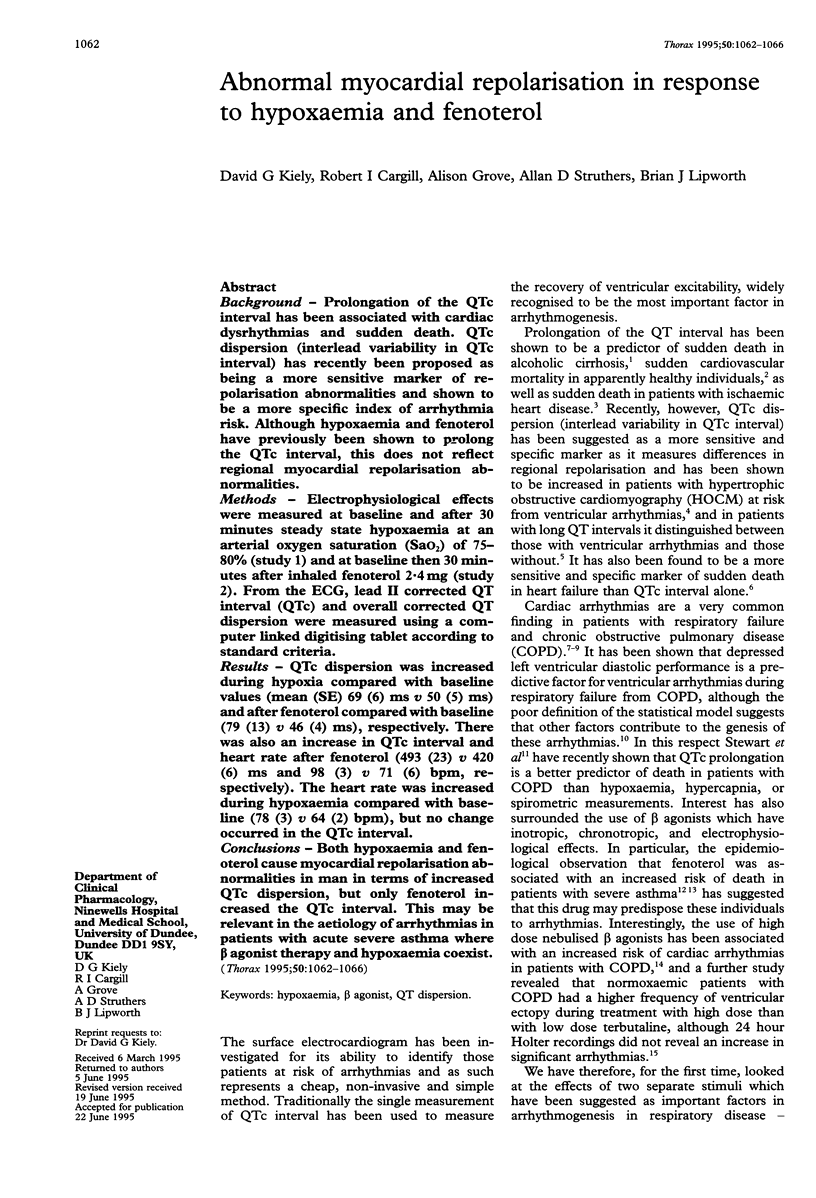
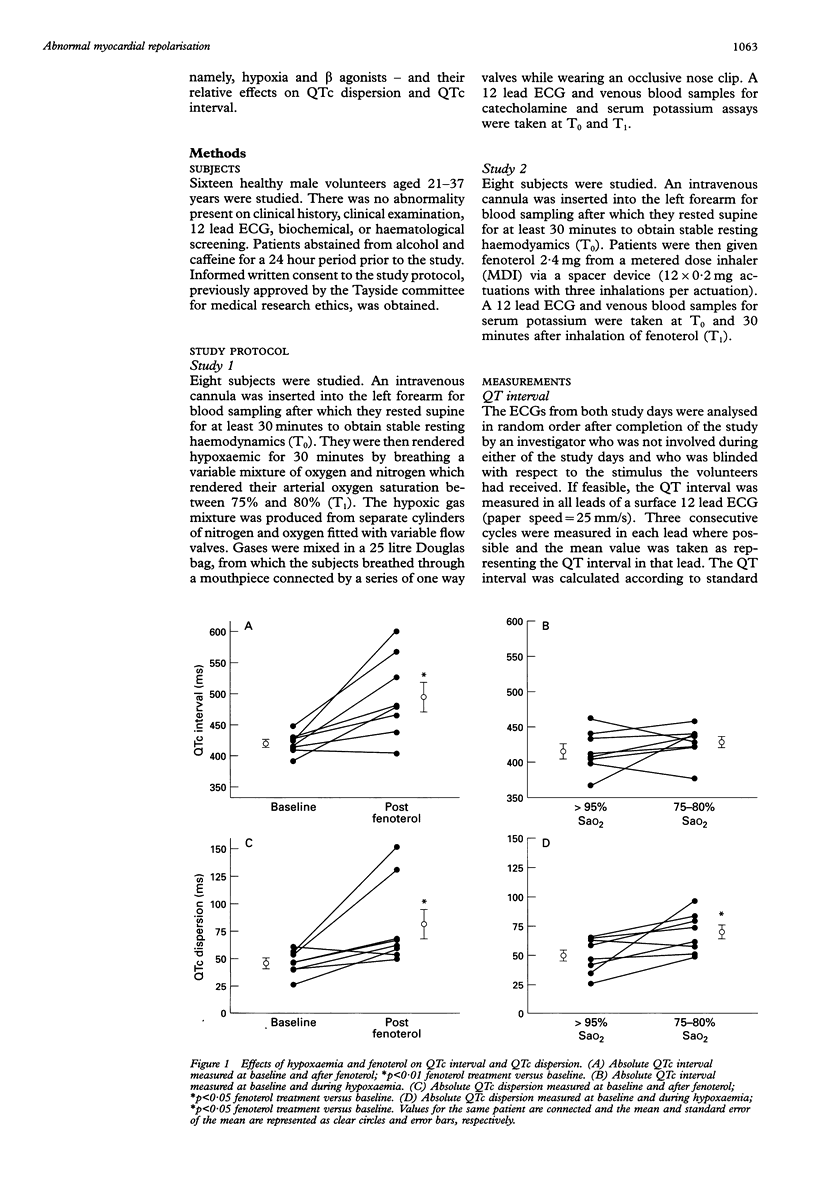
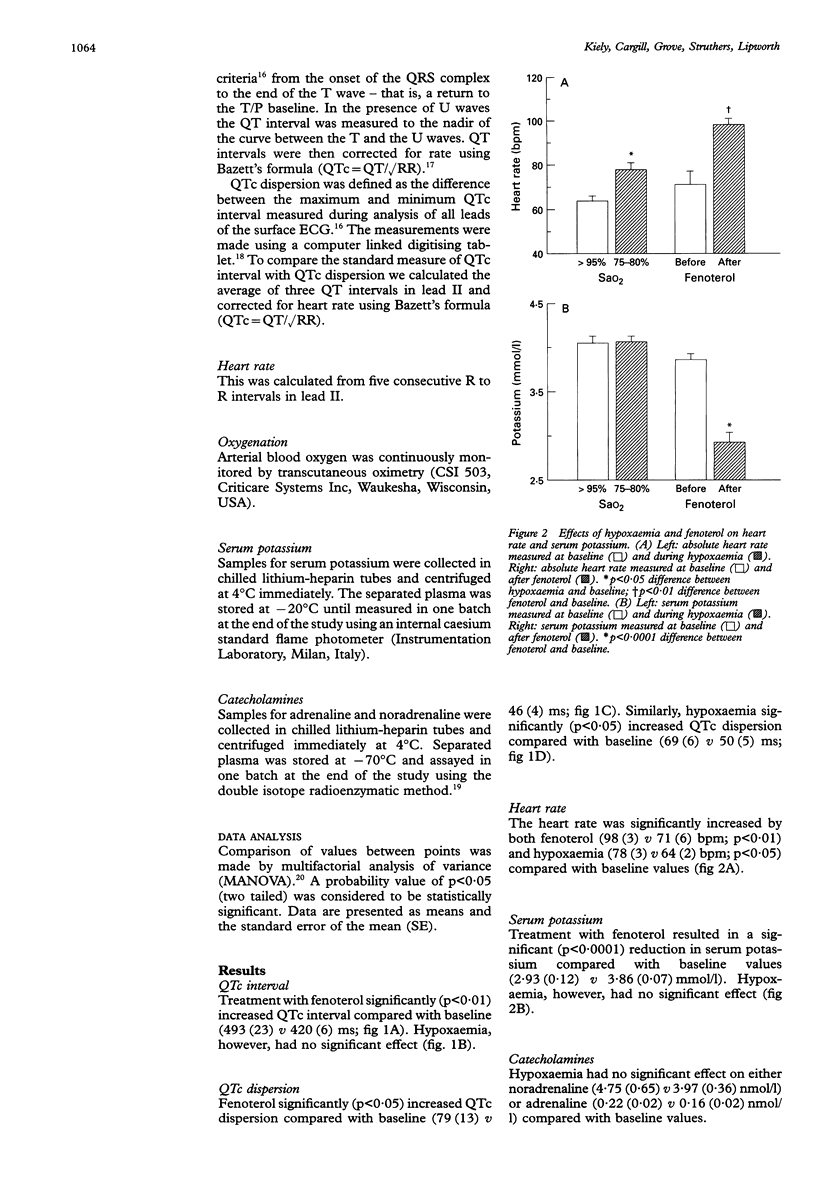
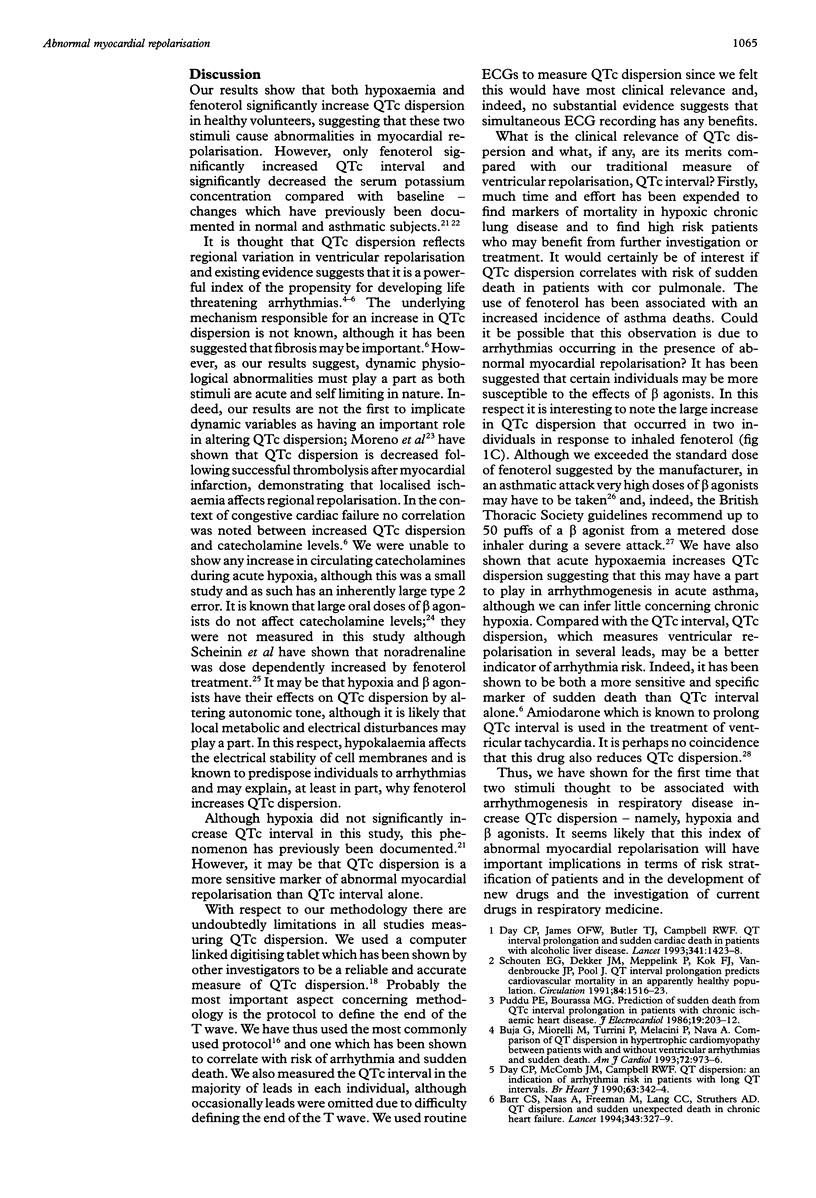
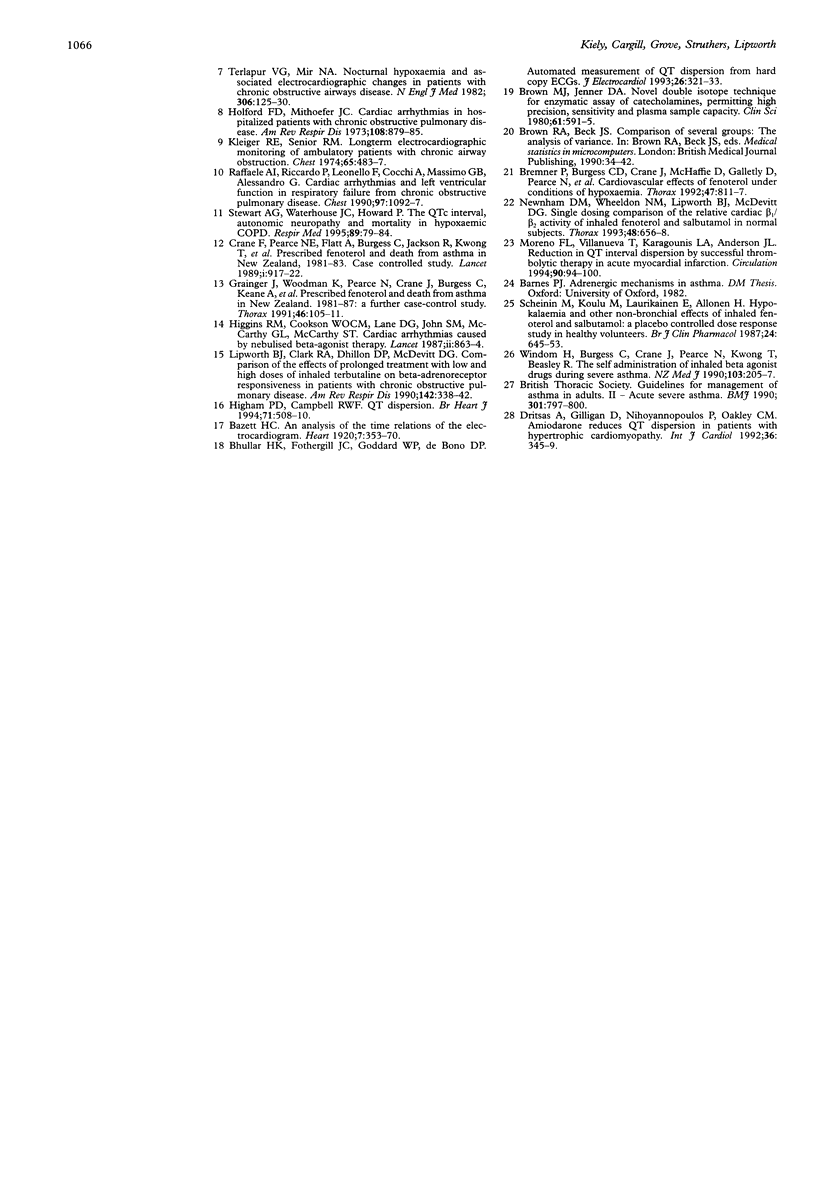
Selected References
These references are in PubMed. This may not be the complete list of references from this article.
- Barr C. S., Naas A., Freeman M., Lang C. C., Struthers A. D. QT dispersion and sudden unexpected death in chronic heart failure. Lancet. 1994 Feb 5;343(8893):327–329. doi: 10.1016/s0140-6736(94)91164-9. [DOI] [PubMed] [Google Scholar]
- Bhullar H. K., Fothergill J. C., Goddard W. P., de Bono D. P. Automated measurement of QT interval dispersion from hard-copy ECGs. J Electrocardiol. 1993 Oct;26(4):321–331. doi: 10.1016/0022-0736(93)90053-g. [DOI] [PubMed] [Google Scholar]
- Brown M. J., Jenner D. A. Novel double-isotope technique for enzymatic assay of catecholamines, permitting high precision, sensitivity and plasma sample capacity. Clin Sci (Lond) 1981 Nov;61(5):591–598. doi: 10.1042/cs0610591. [DOI] [PubMed] [Google Scholar]
- Buja G., Miorelli M., Turrini P., Melacini P., Nava A. Comparison of QT dispersion in hypertrophic cardiomyopathy between patients with and without ventricular arrhythmias and sudden death. Am J Cardiol. 1993 Oct 15;72(12):973–976. doi: 10.1016/0002-9149(93)91118-2. [DOI] [PubMed] [Google Scholar]
- Crane J., Pearce N., Flatt A., Burgess C., Jackson R., Kwong T., Ball M., Beasley R. Prescribed fenoterol and death from asthma in New Zealand, 1981-83: case-control study. Lancet. 1989 Apr 29;1(8644):917–922. doi: 10.1016/s0140-6736(89)92505-1. [DOI] [PubMed] [Google Scholar]
- Day C. P., James O. F., Butler T. J., Campbell R. W. QT prolongation and sudden cardiac death in patients with alcoholic liver disease. Lancet. 1993 Jun 5;341(8858):1423–1428. doi: 10.1016/0140-6736(93)90879-l. [DOI] [PubMed] [Google Scholar]
- Day C. P., McComb J. M., Campbell R. W. QT dispersion: an indication of arrhythmia risk in patients with long QT intervals. Br Heart J. 1990 Jun;63(6):342–344. doi: 10.1136/hrt.63.6.342. [DOI] [PMC free article] [PubMed] [Google Scholar]
- Dritsas A., Gilligan D., Nihoyannopoulos P., Oakley C. M. Amiodarone reduces QT dispersion in patients with hypertrophic cardiomyopathy. Int J Cardiol. 1992 Sep;36(3):345–349. doi: 10.1016/0167-5273(92)90305-m. [DOI] [PubMed] [Google Scholar]
- Grainger J., Woodman K., Pearce N., Crane J., Burgess C., Keane A., Beasley R. Prescribed fenoterol and death from asthma in New Zealand, 1981-7: a further case-control study. Thorax. 1991 Feb;46(2):105–111. doi: 10.1136/thx.46.2.105. [DOI] [PMC free article] [PubMed] [Google Scholar]
- Higgins R. M., Cookson W. O., Lane D. J., John S. M., McCarthy G. L., McCarthy S. T. Cardiac arrhythmias caused by nebulised beta-agonist therapy. Lancet. 1987 Oct 10;2(8563):863–864. doi: 10.1016/s0140-6736(87)91057-9. [DOI] [PubMed] [Google Scholar]
- Higham P. D., Campbell R. W. QT dispersion. Br Heart J. 1994 Jun;71(6):508–510. doi: 10.1136/hrt.71.6.508. [DOI] [PMC free article] [PubMed] [Google Scholar]
- Holford F. D., Mithoefer J. C. Cardiac arrhythmias in hospitalized patients with chronic obstructive pulmonary disease. Am Rev Respir Dis. 1973 Oct;108(4):879–885. doi: 10.1164/arrd.1973.108.4.879. [DOI] [PubMed] [Google Scholar]
- Incalzi R. A., Pistelli R., Fuso L., Cocchi A., Bonetti M. G., Giordano A. Cardiac arrhythmias and left ventricular function in respiratory failure from chronic obstructive pulmonary disease. Chest. 1990 May;97(5):1092–1097. doi: 10.1378/chest.97.5.1092. [DOI] [PubMed] [Google Scholar]
- Kleiger R. E., Senior R. M. Longterm electrocardiographic monitoring of ambulatory patients with chronic airway obstruction. Chest. 1974 May;65(5):483–487. doi: 10.1378/chest.65.5.483. [DOI] [PubMed] [Google Scholar]
- Lipworth B. J., Clark R. A., Dhillon D. P., McDevitt D. G. Comparison of the effects of prolonged treatment with low and high doses of inhaled terbutaline on beta-adrenoceptor responsiveness in patients with chronic obstructive pulmonary disease. Am Rev Respir Dis. 1990 Aug;142(2):338–342. doi: 10.1164/ajrccm/142.2.338. [DOI] [PubMed] [Google Scholar]
- Moreno F. L., Villanueva T., Karagounis L. A., Anderson J. L. Reduction in QT interval dispersion by successful thrombolytic therapy in acute myocardial infarction. TEAM-2 Study Investigators. Circulation. 1994 Jul;90(1):94–100. doi: 10.1161/01.cir.90.1.94. [DOI] [PubMed] [Google Scholar]
- Newnham D. M., Wheeldon N. M., Lipworth B. J., McDevitt D. G. Single dosing comparison of the relative cardiac beta 1/beta 2 activity of inhaled fenoterol and salbutamol in normal subjects. Thorax. 1993 Jun;48(6):656–658. doi: 10.1136/thx.48.6.656. [DOI] [PMC free article] [PubMed] [Google Scholar]
- Puddu P. E., Bourassa M. G. Prediction of sudden death from QTc interval prolongation in patients with chronic ischemic heart disease. J Electrocardiol. 1986 Jul;19(3):203–211. doi: 10.1016/s0022-0736(86)80030-9. [DOI] [PubMed] [Google Scholar]
- Scheinin M., Koulu M., Laurikainen E., Allonen H. Hypokalaemia and other non-bronchial effects of inhaled fenoterol and salbutamol: a placebo-controlled dose-response study in healthy volunteers. Br J Clin Pharmacol. 1987 Nov;24(5):645–653. doi: 10.1111/j.1365-2125.1987.tb03224.x. [DOI] [PMC free article] [PubMed] [Google Scholar]
- Schouten E. G., Dekker J. M., Meppelink P., Kok F. J., Vandenbroucke J. P., Pool J. QT interval prolongation predicts cardiovascular mortality in an apparently healthy population. Circulation. 1991 Oct;84(4):1516–1523. doi: 10.1161/01.cir.84.4.1516. [DOI] [PubMed] [Google Scholar]
- Stewart A. G., Waterhouse J. C., Howard P. The QTc interval, autonomic neuropathy and mortality in hypoxaemic COPD. Respir Med. 1995 Feb;89(2):79–84. doi: 10.1016/0954-6111(95)90188-4. [DOI] [PubMed] [Google Scholar]
- Tirlapur V. G., Mir M. A. Nocturnal hypoxemia and associated electrocardiographic changes in patients with chronic obstructive airways disease. N Engl J Med. 1982 Jan 21;306(3):125–130. doi: 10.1056/NEJM198201213060301. [DOI] [PubMed] [Google Scholar]
- Windom H. H., Burgess C. D., Crane J., Pearce N., Kwong T., Beasley R. The self-administration of inhaled beta agonist drugs during severe asthma. N Z Med J. 1990 May 9;103(889):205–207. [PubMed] [Google Scholar]


